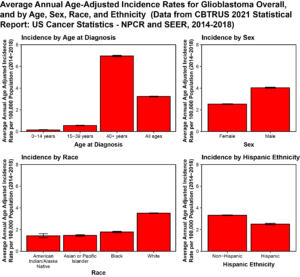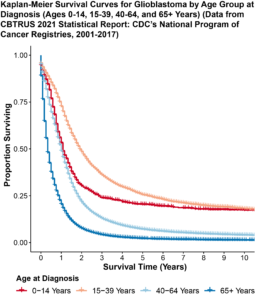
Glioblastoma has the worst outcomes for all cancer types in the U.S.
Glioblastoma is the most common malignant tumor of the brain and central nervous system (CNS), with approximately 12,300 new cases diagnosed annually in the United States between 2014 and 2018.1 Overall, it is the third most common type of tumor reported in the brain and CNS, inclusive of both malignant and non-malignant tumors, and represents 14.3% of all tumors diagnosed in the brain and CNS. Glioblastoma occurs more frequently in older adults, with median age of diagnosis of 65 years and a peak incidence among those 75-84 years old. There are significant demographic differences in populations diagnosed with glioblastoma: they are 60% more common in males than females and nearly twice as common in white individuals as compared to Black individuals.
Breaking Down Survival Rates
Among the 186,632 deaths that occurred in individuals diagnosed with a primary brain tumor in the U.S. from 2001 to 2017, 119,145 (~64%) occurred in those diagnosed with glioblastoma.1 Glioblastoma has among the worst outcomes for all cancer types in the U.S. Only 6.8% of people diagnosed with glioblastoma survived five years post-diagnosis between 2001 and 2017. The median overall survival for those diagnosed between 2001 and 2017 was eight months, though this rises to 12-14 months in individuals who receive surgery and combination chemoradiation. Survival is poorest in the elderly over 65 years old, where five-year survival is 2.7%.2 Survival is higher among females,3 and is poorer in non-Hispanic whites than any other racial ethnic group.4
References
1. Ostrom QT, Cioffi G, Waite K, Kruchko C, Barnholtz-Sloan JS. CBTRUS Statistical Report: Primary Brain and Other Central Nervous System Tumors Diagnosed in the United States in 2014-2018. Neuro Oncol. 2021; 23(12 Suppl 2):iii1-iii105.
2. Low JT, Ostrom QT, Cioffi G, et al. Primary brain and other central nervous system tumors in the United States (2014-2018): A summary of the CBTRUS statistical report for clinicians. Neurooncol. Pract. 2022; 9(3):165-182.
3. Ostrom QT, Rubin JB, Lathia JD, Berens ME, Barnholtz-Sloan JS. Females have the survival advantage in glioblastoma. Neuro Oncol. 2018.
4. Ostrom QT, Cote DJ, Ascha M, Kruchko C, Barnholtz-Sloan JS. Adult Glioma Incidence and Survival by Race or Ethnicity in the United States From 2000 to 2014. JAMA Oncol. 2018; 4(9):1254-1262.
For more information on glioblastoma and statistics for all primary brain and other CNS tumors please see:
CBTRUS Statistical Report: Primary Brain and Other Central Nervous System Tumors Diagnosed in the U.S. in 2014–2018
Quinn T Ostrom, Gino Cioffi, Kristin Waite, Carol Kruchko, Jill S Barnholtz-Sloan
Neuro-Oncology, Volume 23, Issue Supplement_3, October 2021, Pages iii1–iii105, https://doi.org/10.1093/neuonc/noab200

Abstract: The Central Brain Tumor Registry of the United States (CBTRUS), in collaboration with the Centers for Disease Control and Prevention (CDC) and National Cancer Institute (NCI), is the largest population-based cancer registry focused exclusively on primary brain and other central nervous system (CNS) tumors in the U.S. and represents the entire U.S. population. This report contains the most up-to-date population-based data on primary brain tumors available and supersedes all previous reports in terms of completeness and accuracy and is the first CBTRUS Report to provide the distribution of molecular markers for selected brain and CNS tumor histologies.
All rates are age-adjusted using the 2000 U.S. standard population and presented per 100,000 population. The average annual age-adjusted incidence rate (AAAIR) of all malignant and non-malignant brain and other CNS tumors was 24.25 (Malignant AAAIR=7.06, Non-malignant AAAIR=17.18). This overall rate was higher in females compared to males (26.95 versus 21.35) and non-Hispanics compared to Hispanics (24.68 versus 22.12). The most commonly occurring malignant brain and other CNS tumor was glioblastoma (14.3% of all tumors and 49.1% of malignant tumors), and the most common non-malignant tumor was meningioma (39.0% of all tumors and 54.5% of non-malignant tumors).
Glioblastoma was more common in males, and meningioma was more common in females. In children and adolescents (age 0–19 years), the incidence rate of all primary brain and other CNS tumors was 6.21. An estimated 88,190 new cases of malignant and non-malignant brain and other CNS tumors are expected to be diagnosed in the US population in 2021 (25,690 malignant and 62,500 non-malignant). There were 83,029 deaths attributed to malignant brain and other CNS tumors between 2014 and 2018. This represents an average annual mortality rate of 4.43 per 100,000 and an average of 16,606 deaths per year. The five-year relative survival rate following diagnosis of a malignant brain and other CNS tumor was 35.6%, for a non-malignant brain and other CNS tumors the five-year relative survival rate was 91.8%.
Get more information on glioblastoma and statistics for all primary brain and other CNS tumors.
What to Read Next
VPR: Leveraging Registry Data for World Trade Center Studies
Since inviting the next round of investigators to utilize NAACCR’s Virtual Pooled Registry Cancer Linkage System (VPR-CLS), six studies have…
NAACCR Weighs in on USCDI+ Cancer Registry Use Case Development
The U.S. Office of the National Coordinator (ONC) recently invited NAACCR to participate in its development of a United States…
VPR: Facilitating Primary and Secondary Sharing of Cancer Registry Data
Cancer registries participating in the Virtual Pooled Registry Cancer Linkage System (VPR) routinely release cancer information for inclusion in and…






